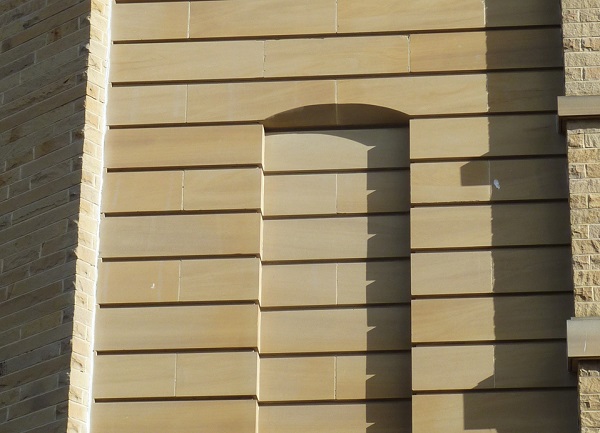Ashlar
Ashlar is a type of masonry which is finely cut and/or worked, and is characterised by its smooth, even faces and square edges. It can also be used to refer to an individual stone that has been finely cut and worked until squared.
Ashlar has been used in construction as an alternative to brick or other materials dating back to classical architecture, where it was often used to contrast with rustication (masonry with a purposefully rough or patterned surface).
Courses of ashlar can be horizontal, with blocks laid in parallel, or may be random with deliberately discontinuous vertical and horizontal joints.
Since ashlar blocks are precisely cut on all faces which are adjacent to other masonry, very thin joints can be achieved. The face of the block away from joints may be left rough and unpolished (known as quarry-faced), or may be polished or rendered decoratively. Mason’s drag is a form of decoration used on softer stone ashlar which involves small grooves applied by a metal comb-like device.
Mortar, or another joining material, is used to bind ashlar blocks together. Other methods of assembly such as metal ties can be used, in a process known as dry ashlar. Such a technique can be seen in the Inca architecture of Cusco and Machu Picchu.
In the UK, ashlar walling can be found in many historic buildings; one notable example being the Royal Crescent in Bath. It is also becoming more popular as a form of exterior cladding in urban commercial developments.
Society for the Protection of Ancient Buildings (SPAB) definition from their online Glossary : 'Finely dressed stone laid in regular courses with thin joints.'
[edit] Related articles on Designing Buildings
Featured articles and news
RTPI leader to become new CIOB Chief Executive Officer
Dr Victoria Hills MRTPI, FICE to take over after Caroline Gumble’s departure.
Social and affordable housing, a long term plan for delivery
The “Delivering a Decade of Renewal for Social and Affordable Housing” strategy sets out future path.
A change to adoptive architecture
Effects of global weather warming on architectural detailing, material choice and human interaction.
The proposed publicly owned and backed subsidiary of Homes England, to facilitate new homes.
How big is the problem and what can we do to mitigate the effects?
Overheating guidance and tools for building designers
A number of cool guides to help with the heat.
The UK's Modern Industrial Strategy: A 10 year plan
Previous consultation criticism, current key elements and general support with some persisting reservations.
Building Safety Regulator reforms
New roles, new staff and a new fast track service pave the way for a single construction regulator.
Architectural Technologist CPDs and Communications
CIAT CPD… and how you can do it!
Cooling centres and cool spaces
Managing extreme heat in cities by directing the public to places for heat stress relief and water sources.
Winter gardens: A brief history and warm variations
Extending the season with glass in different forms and terms.
Restoring Great Yarmouth's Winter Gardens
Transforming one of the least sustainable constructions imaginable.
Construction Skills Mission Board launch sector drive
Newly formed government and industry collaboration set strategy for recruiting an additional 100,000 construction workers a year.
New Architects Code comes into effect in September 2025
ARB Architects Code of Conduct and Practice available with ongoing consultation regarding guidance.
Welsh Skills Body (Medr) launches ambitious plan
The new skills body brings together funding and regulation of tertiary education and research for the devolved nation.
Paul Gandy FCIOB announced as next CIOB President
Former Tilbury Douglas CEO takes helm.
UK Infrastructure: A 10 Year Strategy. In brief with reactions
With the National Infrastructure and Service Transformation Authority (NISTA).























